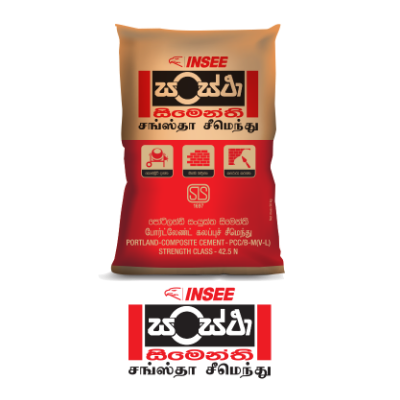
INSEE Hi-Crete
Sustainable High Performing Concrete
INSEE HI-CRETE PORTLAND COMPOSITE CEMENT is the result of years of research and development, engineered with INSEE’s trademarked newly introduced SmartActTM Complex Organo-Mineral Technology
under the newly established Sri Lanka Standard SLS 1697:2021 Specification for Portland-Composite Cement (PCC). INSEE HI-CRETE PORTLAND COMPOSITE CEMENT is produced as two variants; a ternary composition Combining of either fly ash or slag with high-grade calcium carbonate.
Optimum particle size distribution and high packing density of INSEE HI-CRETE PORTLAND COMPOSITE CEMENT ensures the consumption of less mixing water, while its reduced clinker percentage results in the reduction of the carbon footprint of the cement product, making INSEE HI-CRETE PORTLAND COMPOSITE CEMENT more environmentally friendly than OPC.
Fact File
| Name : | INSEE HI-CRETE CEMENT |
| Type : | Portland-Composite Cement |
| Sri Lankan Standard : |
SLS 1697 |
| Strength Class : | 42.5N/R |
| British Standard: | BS EN 197 CEM II-B/M |
Properties
| PROPERTY | SLS 1247 : 2015 REQUIREMENT |
HI-CRETE/PCC |
|---|---|---|
| PHYSICAL PROPERTIES | ||
| Compressive Strength (2 days) | ≥ 10 N/mm2 | ≥ 20 N/mm2 |
| Compressive Strength (28 days) | 42.5 – 62.5 N/mm2 | 52 N/mm2 |
| Setting Time | ≥ 60 minutes | 130 – 150 minutes |
| Fineness | Not Specified in Standard | 400 – 420 m2/kg |
| Soundness | < 10 mm | < 1 mm |
| Relative Density | Not specified in standard | 2.96 |
| CHEMICAL PROPERTIES | ||
| SO3 | ≤ 3.0 % | <2.8 % |
| Chloride | ≤ 0.1 % | <0.05 % |
| LOI | Not specified in standard | <3.0 % |
Compatibility
INSEE HI-CRETE is compatible with:
- Chemical Admixtures complying with BS EN 934-1:2008 and ASTM C494
- Fly Ash complying with BS EN 450
- Ground Granulated Blast Furnace Slag (GGBFS) complying with BS EN 15167-1:2006
- Silica Fume complying with BS EN 13263-1:2005+A1:2009
- Manufactured Sand (M-Sand) complying with BS EN 12620:2013
- Natural Sand, Quarry Sand and Offshore Sand complying with BS EN 12620:2013
Applications
INSEE HI-CRETE is used for:
- Sustainable and high performing Structural concrete for buildings, commercial and infrastructure projects
- Sustainable and durable concrete structure from foundation to roof
- High durable road construction
- Ideal solution for concrete elements in contact with marine environment and aggressive soil or underground water such as sulphate, chloride and acids
- Easy pumpable concrete with fast casting and demolding
- Large-scale infrastructure development projects with bulk cement requirements
- High-rises and large-scale housing and commercial projects with the requirement for sustainable high performing concrete
- Concrete with low carbon footprint
Features and Benefits
Sustainable High Performing Cement
While OPC undergoes one reaction to form calcium-silicate hydrate gel (C-S-H) – the glue that holds concrete together – INSEE PCC CEMENT undergoes THREE reactions with INSEE’s trademarked SmartActTM Technology, promoting refinement of the pore structure of matured concrete. INSEE PCC CEMENT first undergoes the hydration reaction. This is followed by the pozzolanic reaction. A third nucleation reaction unique to INSEE PCC CEMENT further accelerates the hydration and formation of additional carbonate aluminate hydrate (C-A-H) growing between the capillarity pores, resulting in a denser microstructure as well as higher strength and durability at each level of maturity.
Higher Sulphate and Chloride Resistance
The very dense microstructure and low porosity makes INSEE PCC CEMENT the ideal product to be used in constructions in aggressive environments that contain sulphate in ground water or soils, salts and acids or any other exposure conditions.
Alkali Aggregate Reaction (AAR) Resistance
Fly ash and slag as cementitious constituents used in INSEE PCC CEMENT reduces the alkali aggregate reaction (AAR) by bonding chemically the soluble alkalis in the cement
Mass Pouring
Featuring low heat of hydration development at early age, INSEE PCC CEMENT is highly recommended for mass concrete works, and the preferred solutions in hot weather conditions especially in tropical countries.
Environmentally Friendly
the new INSEE PCC contains up to 35% less clinker in its composition. INSEE PCC CEMENT also has an optimum particle size distribution with a high packing density which results in superior fresh and hardened concrete properties with high water retention, thus reducing the required mixing water to achieve the desirable workability with potential mix design and cost optimisation.
Superior Workability
The finely engineered particles of high-grade calcium carbonate (CaCO3), finely blended slag, and spherical fly ash particles all act as lubricant, reducing water demand for the mixture while also increasing the fluidity and workability of the cement.
Water Protect
Rainwater enters concrete through open pores and capillary voids. The new INSEE PCC CEMENT formulation results in a very dense and impermeable concrete microstructure with very less voids and connected capillary pores. The optimal particle size distribution also means maximum packing density of the concrete, offering complete protection against water penetration and infiltration.









